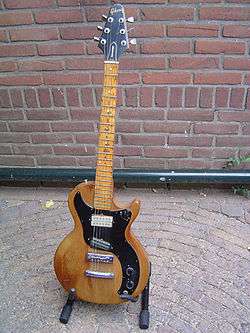Gibson Marauder
| Gibson Marauder | |
|---|---|
 | |
| Manufacturer | Gibson |
| Period | 1974—1979 |
| Construction | |
| Body type | Solid |
| Neck joint | Bolt-on |
| Scale | 24.75 in (629 mm) |
| Woods | |
| Body | Alder, Mahogany, Maple |
| Neck | Maple |
| Fretboard | Maple, Rosewood, Ebony |
| Hardware | |
| Bridge | Tune-o-matic, and "Short Lyre Vibrola" used on some models |
| Pickup(s) | H-SC: Bill Lawrence Humbucker (neck), Bill Lawrence Blade Noiseless Single-coil (bridge) |
| Colors available | |
| Classic White, Cherry, Ebony, Natural | |
The Gibson Marauder was an electric guitar model produced by Gibson. Around 7,111 were made between 1975 and ’79 and 1 prototype in 1974. Most common was the natural satin finish on 4,758 of the Marauders. 1,368 Marauders were finished in the colour wine-red, 460 were finished in Ebony, 240 in tobacco sunburst, 202 Marauders without specified finish were mentioned in Gibson's shipping lists, and 83 Marauder Customs were made only in the tobacco sunburst finish. (http://www.vintageguitarandbass.com/gibson/Marauder_2.php) A handful more built until 1982.[1] Designed to compete with guitars made by Fender, it had limited success and was discontinued.
History
The Marauder came at a difficult time for American guitar makers: sales in the early 1970s were down, and there was significant competition from Japanese competitors. It was Gibson's attempt to break into the single coil pickup, bolt-on neck guitar market dominated by Fender. In cooperation with Bill Lawrence, who had joined Gibson in 1972 and had already produced the L6-S, the Marauder was developed to compete with Fender, and had a pickup layout reminiscent of the Fender Telecaster, though in fact it had two humbucker pickups.[2]
The guitar, though officially introduced in 1974, began shipping in 1975 and was endorsed by Ace Frehley and Paul Stanley. Minor modifications were made in 1976 and in 1978; it was cancelled in 1979 though some were still made until 1982. In all, fewer than 7,200 were ever made.[2]
Description
The Marauder sports a contoured single cutaway Les Paul-shaped body, and a bolt on maple neck with a headstock similar to the Flying V's. Marauders were made with alder, maple, or mahogany bodies. The fretboard was produced both in the traditional Gibson rosewood, or the more Fender-like maple, with twenty-two frets. Most had dot markers, "though some may have had trapezoid."[2]
The Marauder featured custom-designed Bill Lawrence pickups sealed in clear epoxy. The guitar had a regular-sized humbucker pickup in the neck position and a small humbucker, in a blade style resembling a single coil, was mounted at an angle by the bridge (Telecaster-style). This arrangement resembles the Fender Telecaster Custom. The resulting sound was closer to the Fender sound than that of most Gibson guitars, with more higher frequencies than regular Gibsons.[2]
Early Marauders had a three-way toggle switch on the treble side of the upper bout of the body (opposite the location on Les Pauls and ES-175s, similar to a Gibson Byrdland), to turn on either one or both pickups. In 1976, a rotary potentiometer was introduced which allowed a range of blends between the two pickups. In still later Marauders, the potentiometer (now a chickenhead knob) was positioned between the volume and tone knobs.
Marauders all had Schaller made "Harmonica" ("tune-o-matic" style) bridges and the standard Gibson stopbar tailpiece. They had enclosed "Gibson Deluxe" tuners, and typical Gibson strap buttons.
The Marauder has been famously used by SUM 41 lead vocalist and guitarist Deryck Whibley and can be seen used in their video for Fat Lip.
References
- ↑ "Living in the '70s: The Gibson Marauder". www.gibson.com. Retrieved 2015-09-30.
- 1 2 3 4 Wright, Michael (November 2009). "The Gibson Marauder M-1". Vintage Guitar. pp. 52, 114.
| Wikimedia Commons has media related to Gibson Marauder. |